How to Export WooCommerce Customer Data
Have you ever wanted to be able to create a custom export of your WooCommerce customer data? Maybe there is only a certain type of customer information that you want to export, or you want to export only a section of your customer list. In this article, we will show you how to create custom WooCommerce exports of your customer data (in a CSV format) with the help of the Users Insights custom export feature.
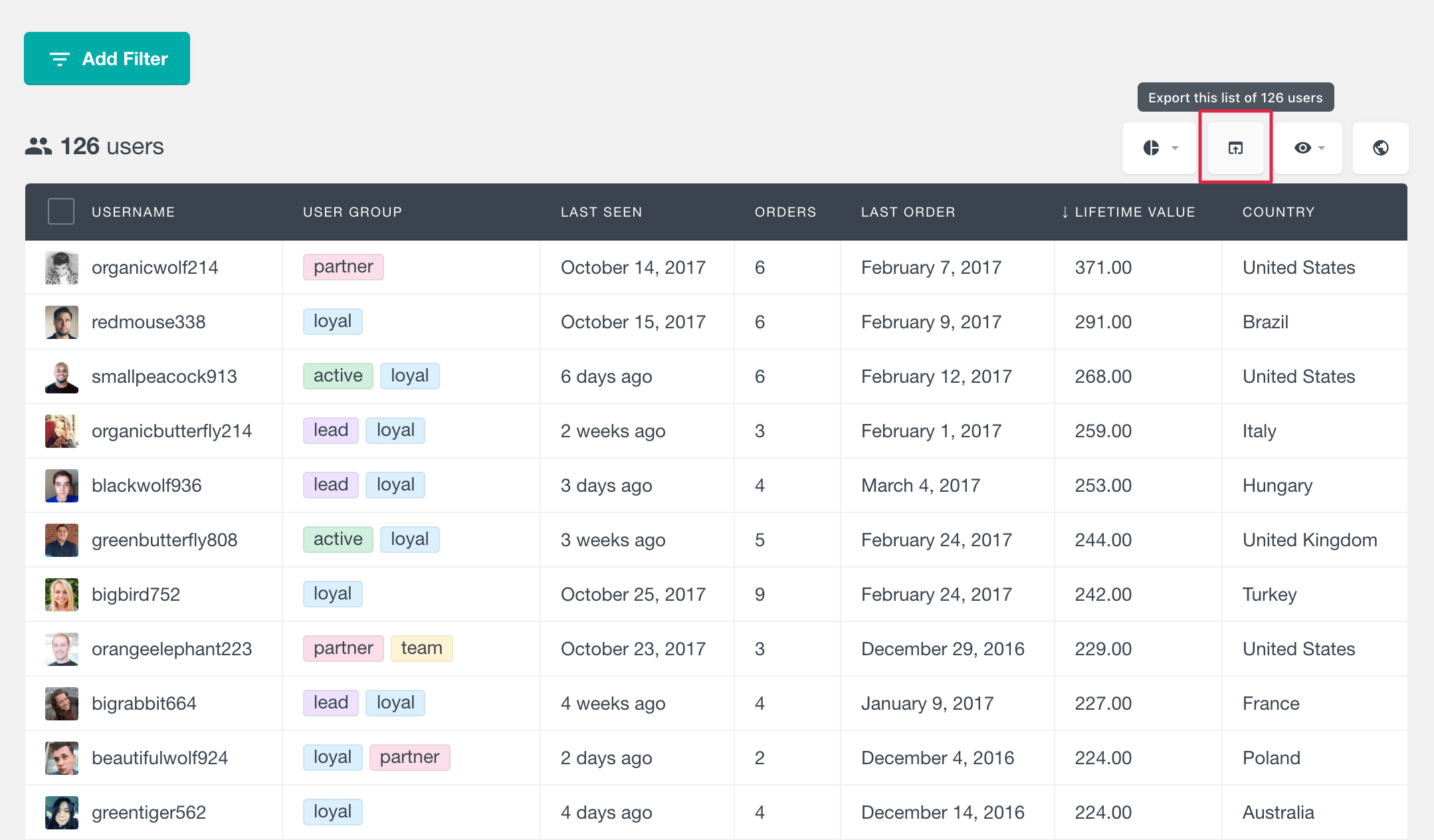
The custom export functionality of Users Insights gives you the option to export WooCommerce customers from an already segmented list. You also have the option to choose the fields that will be included in the exported file.
How to export the WooCommerce customer list
There are two ways to export your WooCommerce customers. The first is to export WooCommerce customers without a plugin.
WooCommerce Customers Built-in export feature
You will need to use the default WordPress export tool or WooCommerce export feature. The default WordPress tool will export your data in XML format that does not only contain WordPress user data but will contain all the data in one big file. This export type is used to import and export data between two WordPress sites. This export WordPress feature is created mainly to migrate customer data from one WordPress website to another and does not provide any customization. The downside to this method is the limitation on the ability to customize any.
To export WooCommerce users who are not guest customers using the WordPress export tool, go to the WordPress dashboard Tools > Export and select from the list of export options. This will generate an XML file of your user data, which you can download and save.
Export WooCommerce Customers with a plugin
The second option is to use a dedicated WooCommerce export plugin. In this tutorial, we are going to focus on the second option.

Why create a custom customer export
In most cases, the reason why you need to create an export of your customer data is so that you can import this data into another system.
How to export all WooCommerce customer data
To export customer data from WooCommerce using the Users Insights plugin, you can follow these steps:
- Install and activate the Users Insights plugin.
- Navigate to the Users Insights custom export feature and select the fields you want to export.
- Filter the WordPress Users or WooCommerce customers to export or choose from already segmented lists.
- Click on the Export Data button to run the export
- Download the data to a CSV file.

First, let’s see how to export all customer info from WooCommerce simultaneously. If you click on the export button from the menu, a prompt dialog will show up and ask you if you are sure that you want to export all the WooCommerce customer data and information. If this is what you want, you can confirm your export. This will start the generation and download the WooCommerce customer list and all of the customer data included in the export file in a CSV format on your computer:
Once the CSV file is generated and downloaded to your computer, you can open it. The file will look like this:
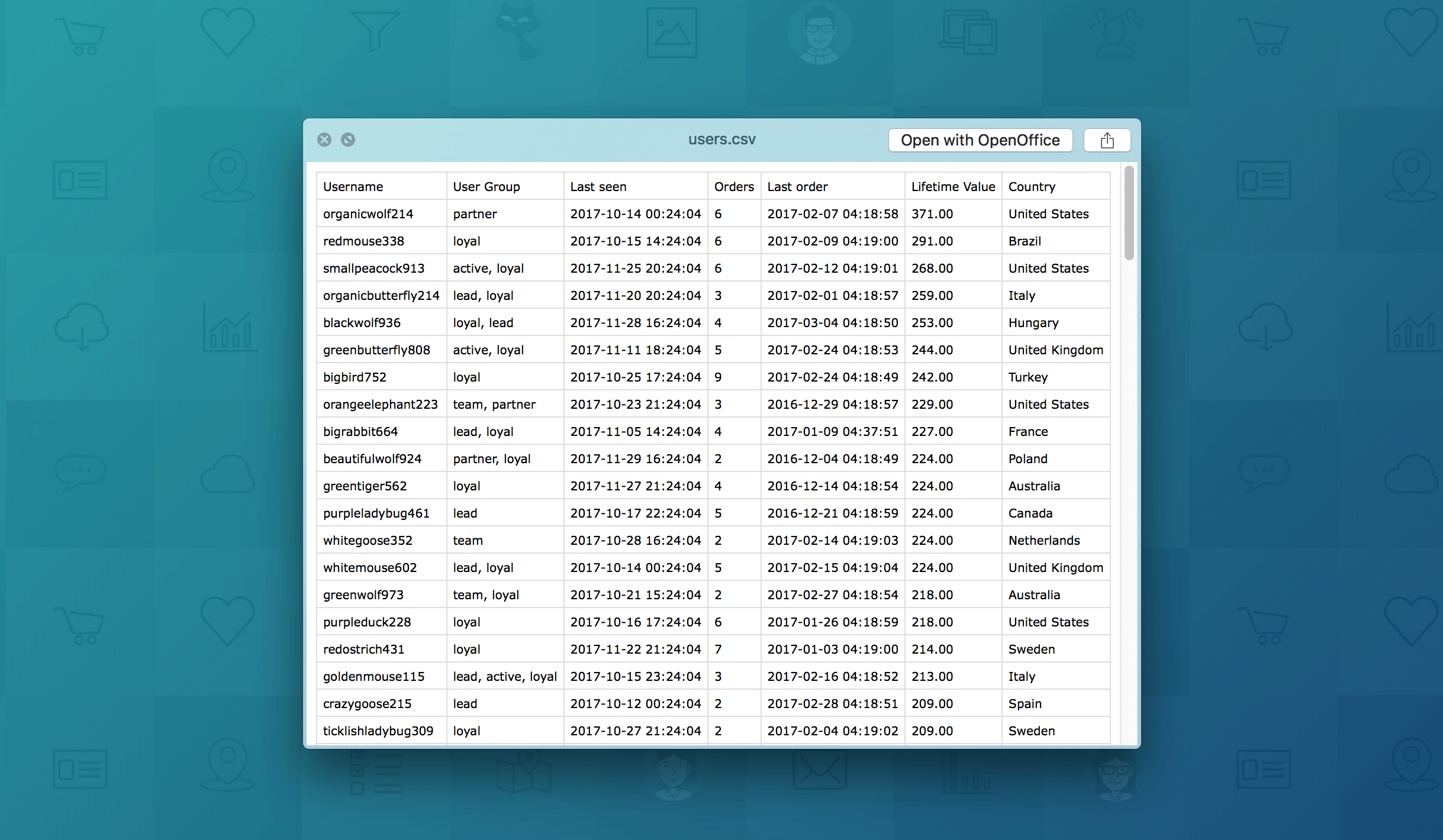
Customizing the customer information and fields to be included
As you can see from the downloaded file, the fields in the exported file are the same as the fields in the Users Insights table. Users Insights will export only the fields shown in your customer list. So, if there are some fields that you want to be included in the export, you have to make them visible on the Users Insights table before you do the export. You can show and hide fields from the “Eye” menu on the table.
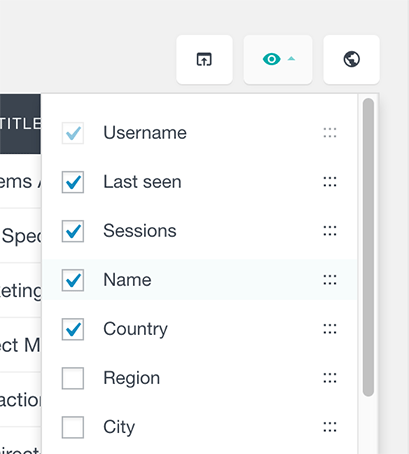
From this section, you can also change the order in which the columns will be exported by dragging and dropping them to different positions.
Creating custom WooCommerce customer exports
Customizing the sorting order of the export file
You might have also noticed that the data in the exported file is in the same sorting order as in our Users Insights table. If you want the exported file sorted by a specific column, ensure your Users Insights list is sorted similarly before exporting. You can change the sorting order of the customer list by clicking on the column title you would like to sort by.
How to export a custom customer list from WooCommerce
If you want to export only specific customers from your customer list, combine the Users Insights smart filters with the export functionality. All you need to do is apply any filter to the user table and then click on the export button while the filter is applied. Users Insights will export only the customers listed on the Users Insights table. Let’s say you want to export all the customers who haven’t been online in the last 60 days, are from the United States, and have a lifetime value larger than $100. You can easily do this by simply combining the filter “Last seen is less than 60 days” with a second filter, “County is the United States,” and finally adding a “Lifetime value is bigger than” filter:
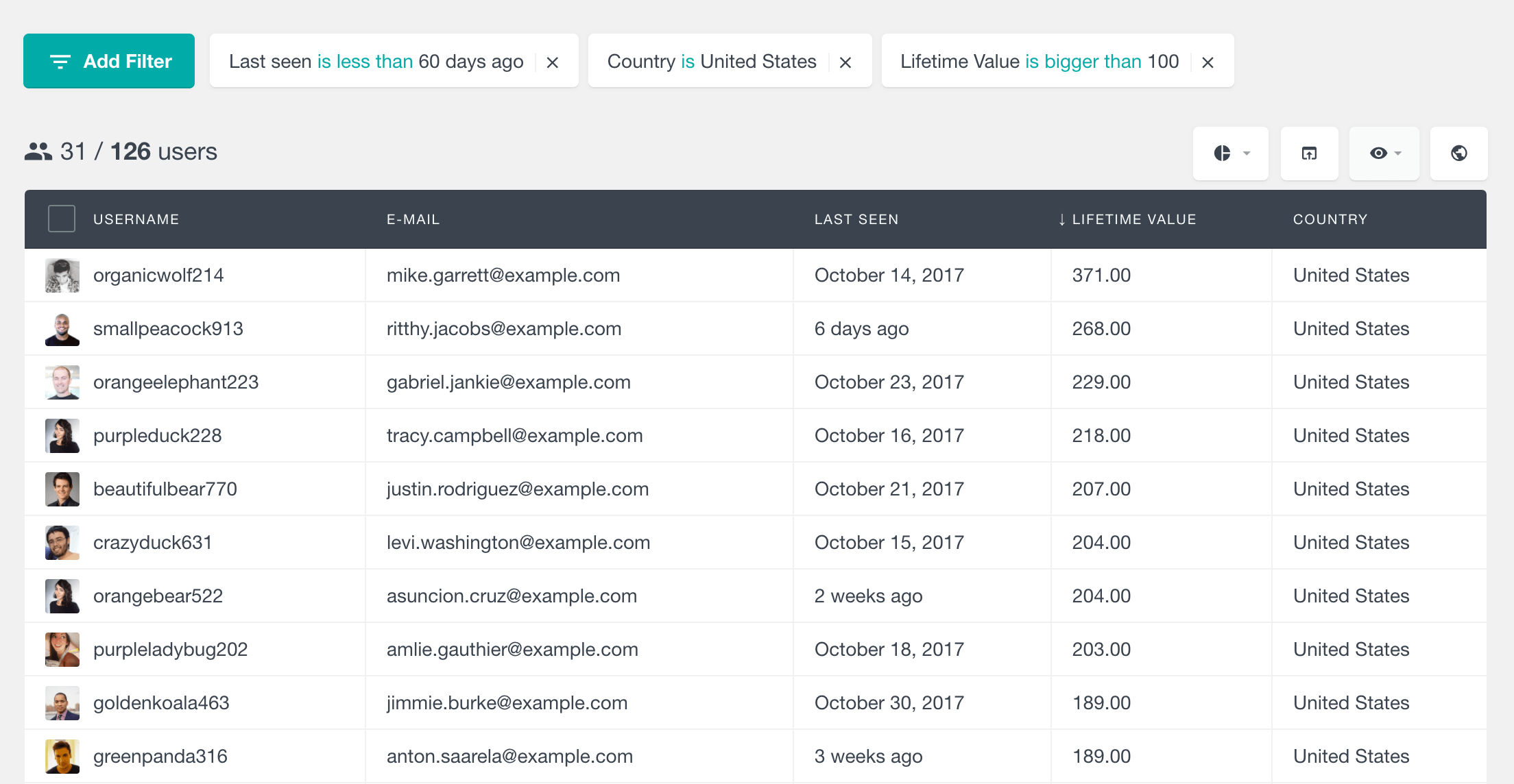
Now, if we want to export our customer list in a CSV file, we can press the export button, and we will get a CSV export file with only these customers:
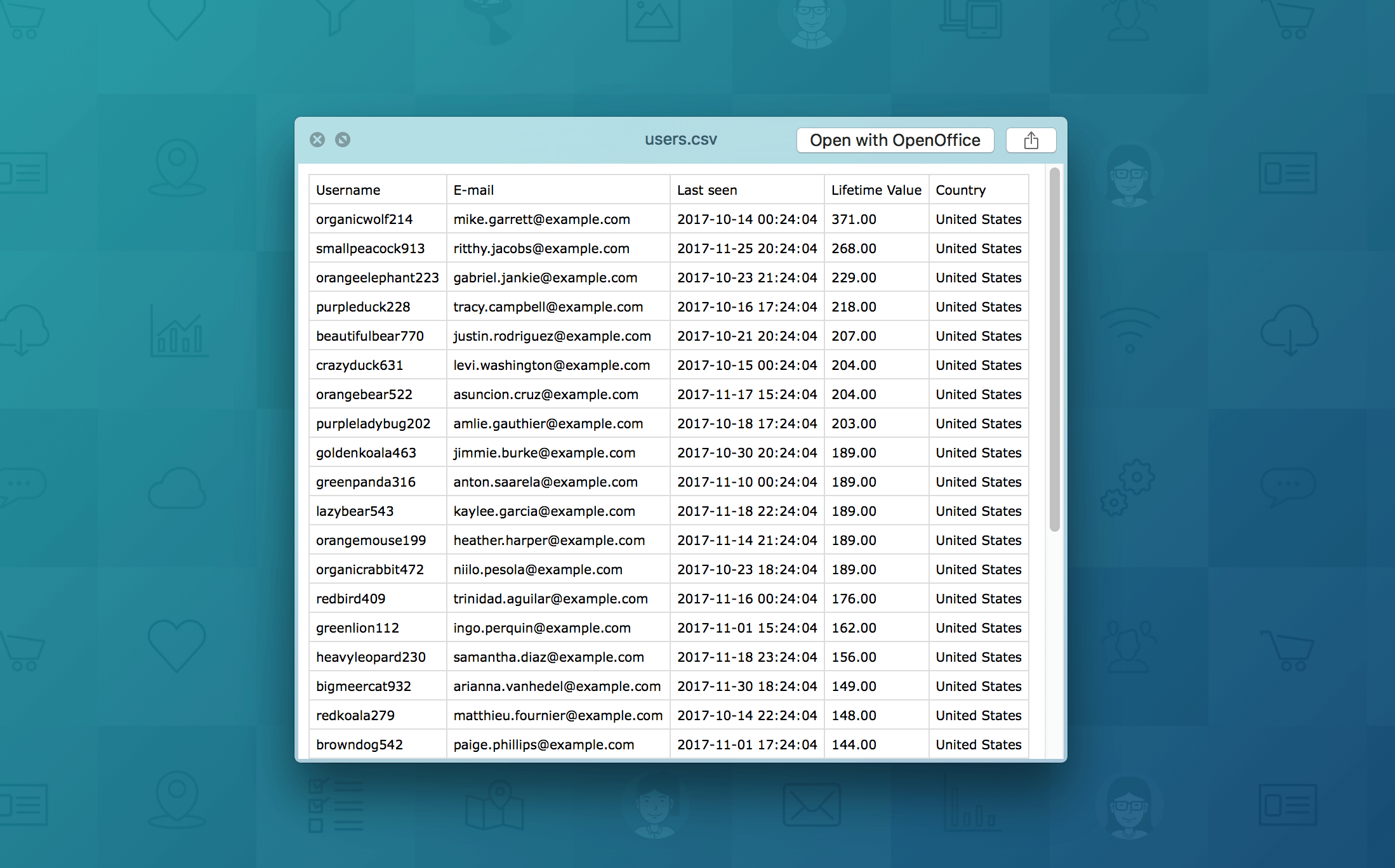
Creating a custom export of WooCommerce customer email addresses
Sometimes, you might need to export the email list of your WooCommerce customers. This could be because you want to import WordPress users into a mailing software like MailChimp or Campaign Monitor, or you may need a list with the most basic information about your customers.
In our example, we are going to export only the repeat buyers. We’ll also hide all columns except the user’s name and email. Let’s filter our results and have a WooCommerce export of our customer emails:
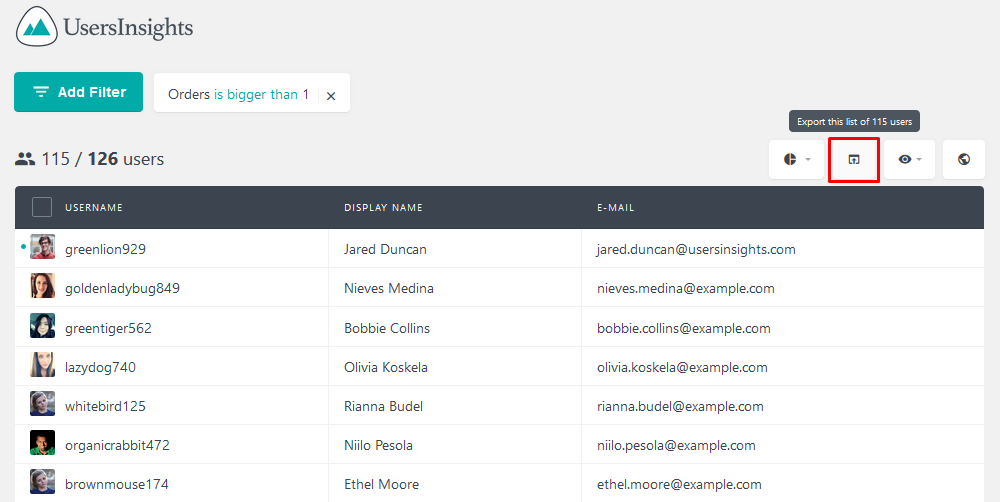
How to export WooCommerce custom fields and custom meta
In addition to simple exports, you may want to add other custom fields to your CSV export. These custom fields may be stored by other plugins like user registration plugins or custom fields that you’ve created yourself. For example, you may even use WooCommerce custom fields in your CSV export. Fields such as the billing address or shipping address.
To add these custom fields to your CSV export, you need to map them into Users Insights. You may want to use the Extended WooCommerce Customer Management for Users Insights plugin to make it easier. This plugin lets you easily map custom fields and meta data by choosing one of the keys you already have in your WordPress database. In this way, you don’t have to add them manually. So you need to go to Users Insights > Custom Fields and add the fields you want, for instance, the shipping address.
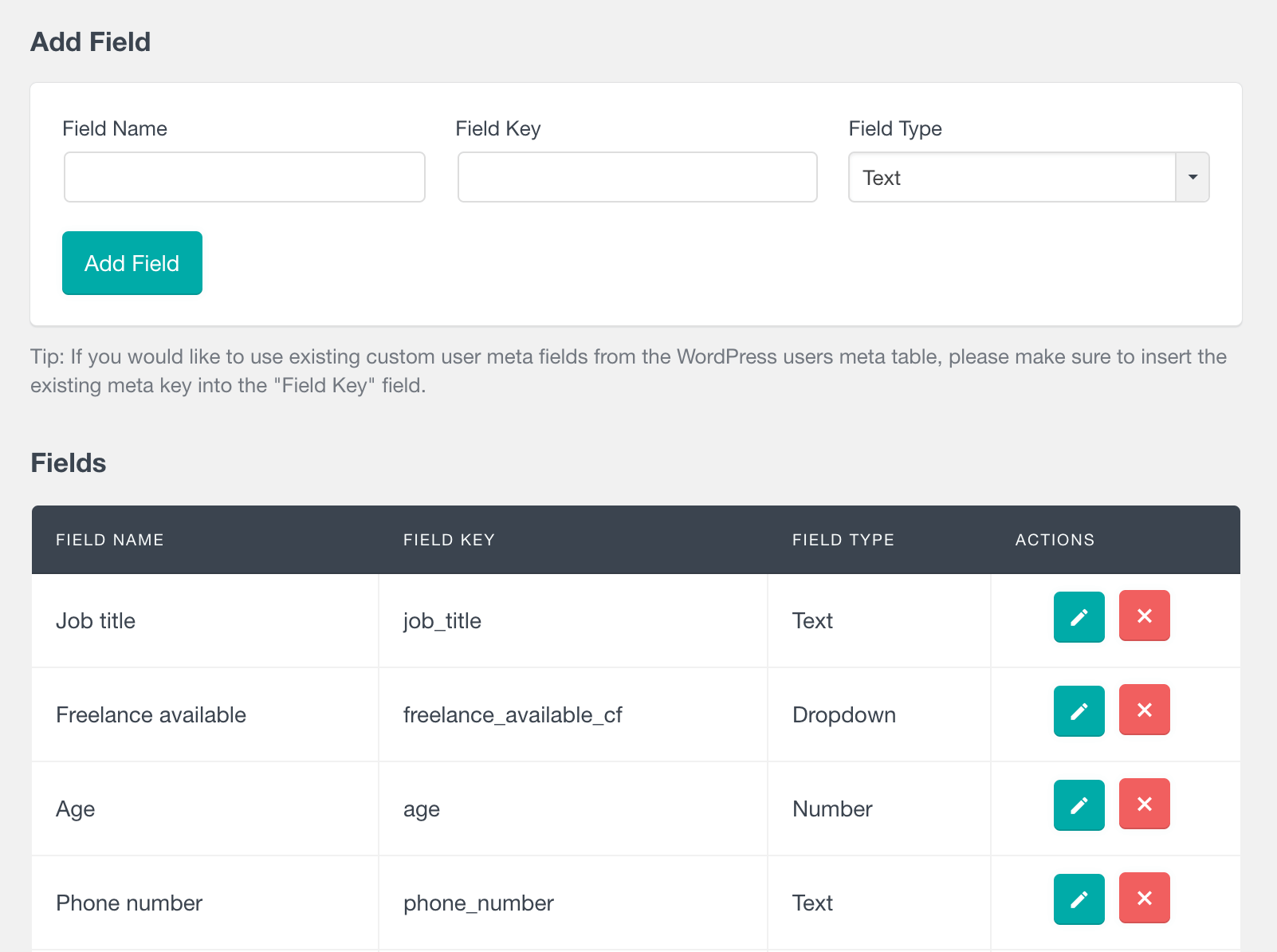
Please note that this will work only with registered customers, not guest ones. Now we have this field in our columns, we can easily add this extra meta data to your WooCommerce user’s export. To do that, ensure you have this WooCommerce column visible in the table. In our case, we’ll use the shipping data from WooCommerce (country and city).
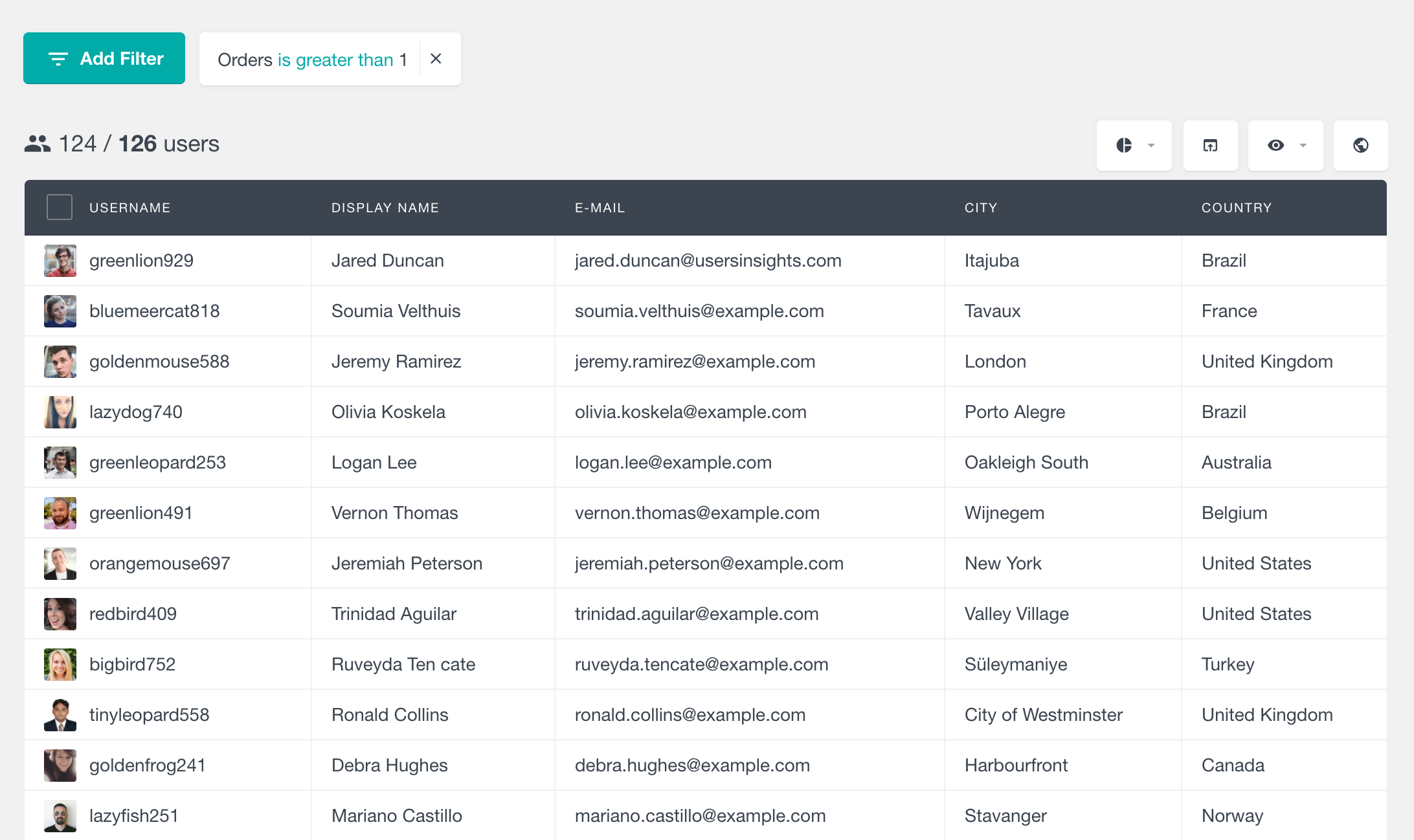
You could use the same process to create a different WooCommerce CSV export for other custom fields. We have a more detailed tutorial on exporting WooCommerce customer addresses if you want a more detailed explanation.
How to export WooCommerce customers by orders and product data
The ability to filter our customers by their order data opens up the possibility of creating custom exports of our WooCommerce customers based on their purchase data. This includes order data like the number of orders, first order data, last order data, lifetime value, and products in the wishlist. Here is a table of all the WooCommerce order data that can be included in the export file:
| WooCommerce export | WooCommerce Subscriptions export | WooCommerce Memberships export |
|---|---|---|
| Number of orders | Number of subscriptions | Number of memberships |
| Number of successful orders | Subscription statuses | Member since |
| First order | Next payment date | Membership statuses |
| Last order date | Active memberships | |
| Lifetime Value | ||
| Number of reviews | ||
| Number of products in wishlist |
For example we can export customers who have ordered specific WooCommerce products and use this data in our targeted email campaign. Or we can do the opposite and export customers who have WooCommerce orders without a specific product and recommend a related product (and maybe send them a discount coupon). Let’s see an example of all customers who have made an order with a specific product:
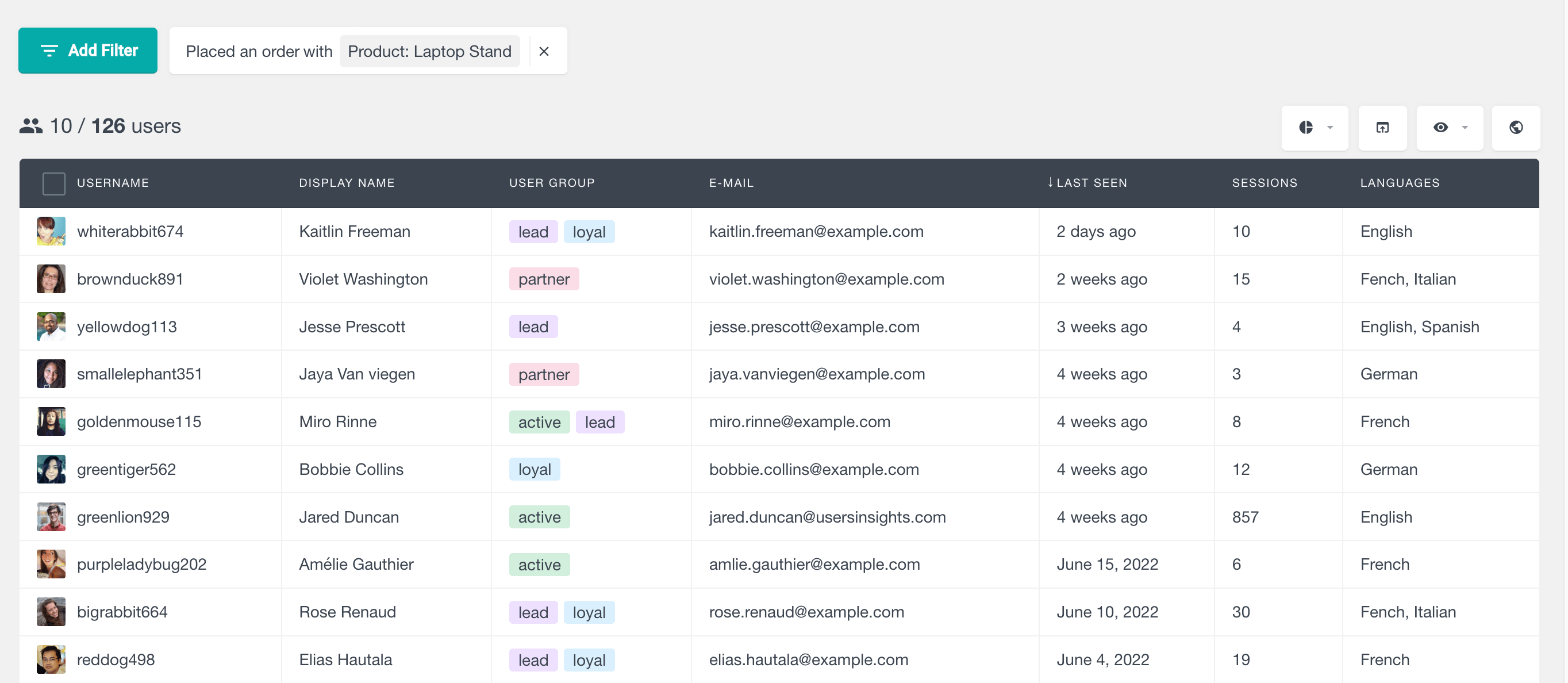
But now let’s say we have a very related product to the ordered product and that we think that it will be a create product recommendation for these customers. We can create another filter that will show us all the customers who have purchased the specific product but not the other:
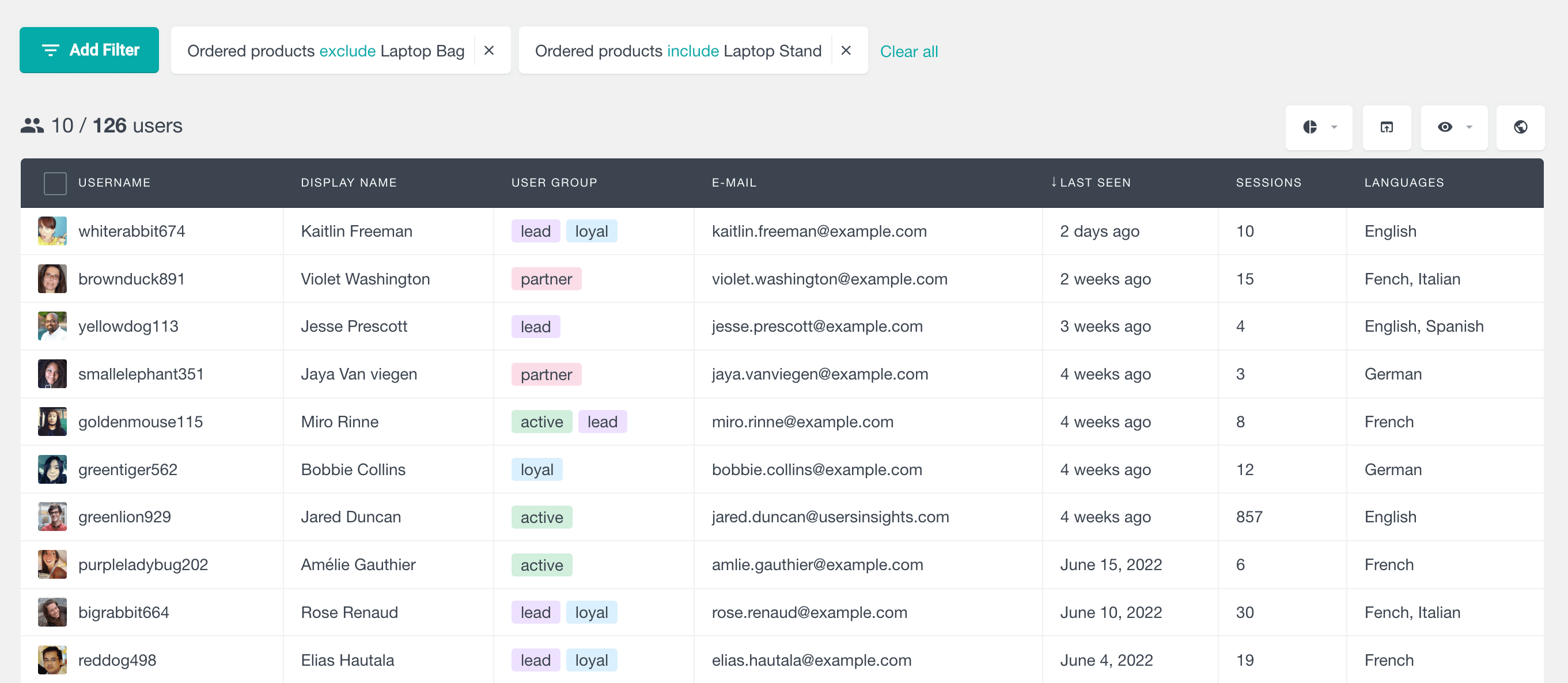
You can export WooCommerce order data if the specific order column is visible in the table. As we can see, the ability to export WooCommerce orders data and WooCommerce product data opens a lot of options and flexibility in how you can create your custom exports.
Export WooCommerce subscriptions and WooCommerce membership data
Since Users Insights comes with out-of-the-box integration for WooCommerce subscriptions and WooCommerce Memberships extensions, you can also export the data from these WooCommerce plugins. For example, you can export WooCommerce subscription data like plan subscription status, next payment date, or number of active subscriptions. Here is an example of how you can easily export WooCommerce subscribers of a specific subscription product only:
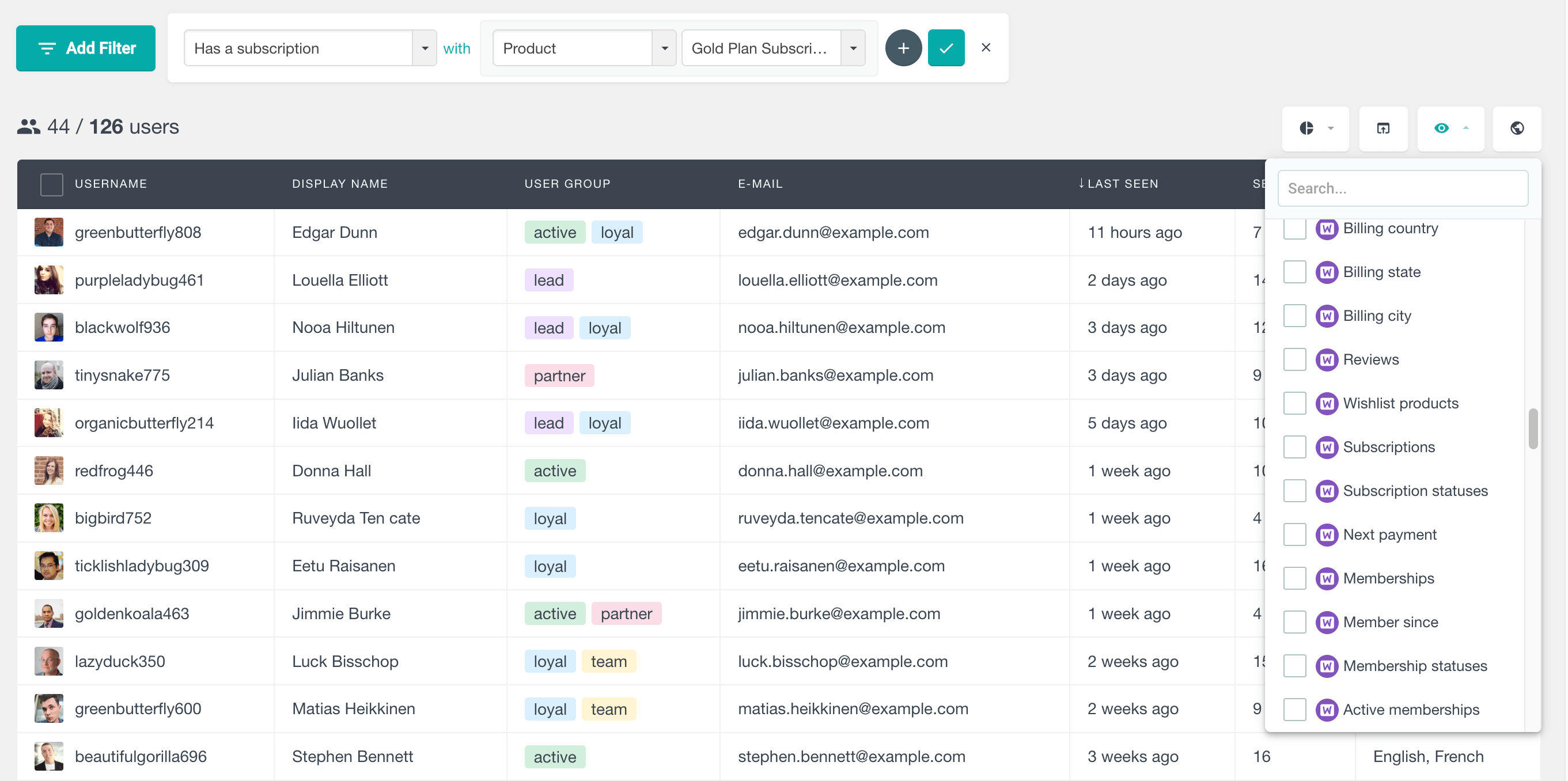
For the Membership extension, you can export data like: Number of memberships active, member since date, membership status, etc. And since all the data is in one place, you can easily export subscription data in combination with data from different plugins and custom fields.
How to export and import WooCommerce customers into CSV, Excel, and Google Sheets
All the exports you create with Users Insights are created in the CSV file. This provides considerable flexibility and portability for the exported WooCommerce data. CSV files are much like Excel or spreadsheet files but with a lot more cross-platform support. Since CSV files are standard and supported by most platforms and tools, you can easily open the export file with Microsoft Excel software or Google Sheets and Google Docs.
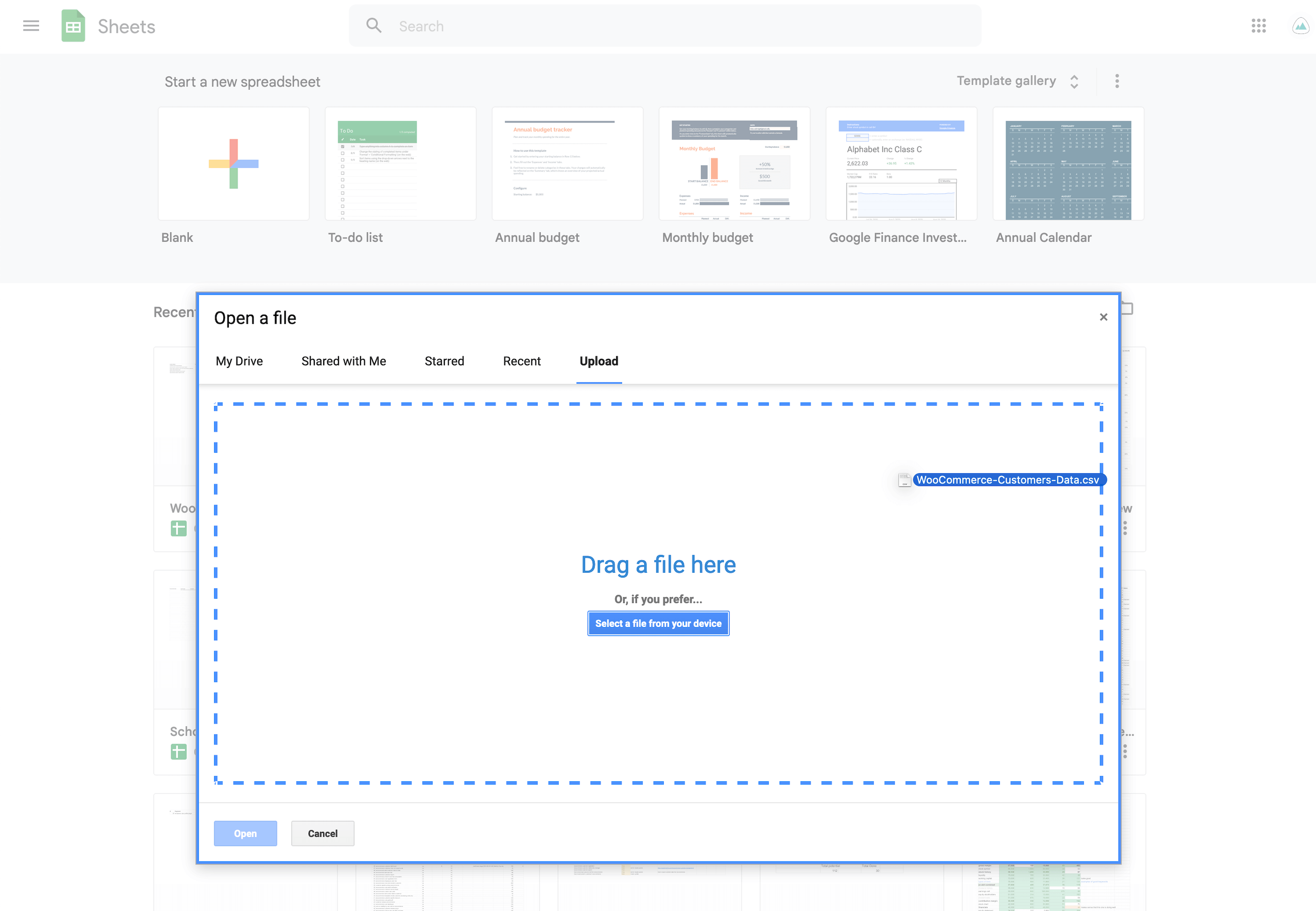
Additionally, having the data in CSV format allows you to import customers into other platforms and tools like marketing software tools or even migrating your WooCommerce users to a completely different eCommerce store.
With the Users Insights filters, you have almost unlimited options to segment your customer list. For example, you can easily export only the customers who have purchased a certain product, export the list of customers with the biggest number of orders, or export WooCommerce users and customers to CSV based on order status, etc. You can also take advantage of the custom segments feature and auto export customers in CSV by having the filters saved as a segment.
Here is a short video showing how you can use the custom exports feature of Users Insights to create your WooCommerce customer exports that contain only the information that you need:
As you can see, the custom export functionality of the Users Insights plugin, in combination with the rest of the plugin features and modules, can be a powerful tool for creating custom exports of your WooCommerce customer data. We hope this article was helpful, and now you can create custom WooCommerce customer exports.
